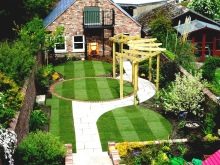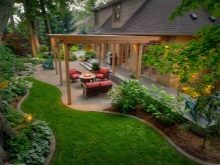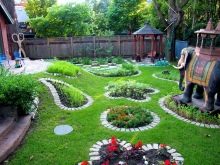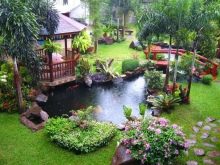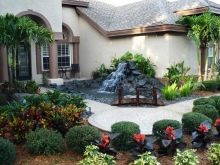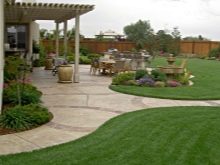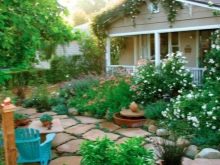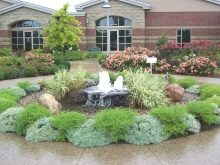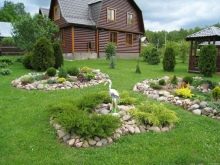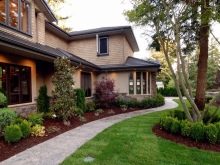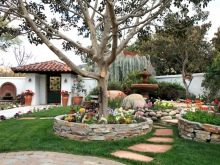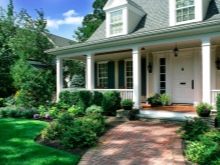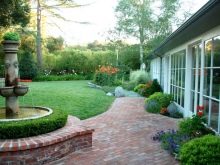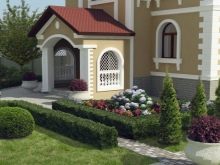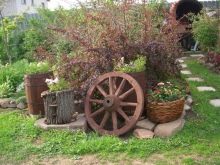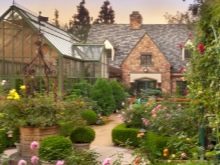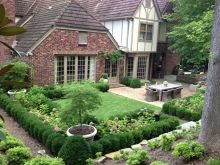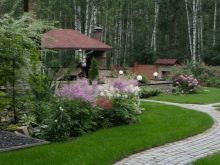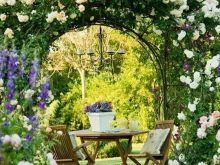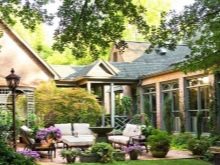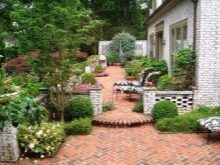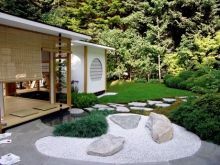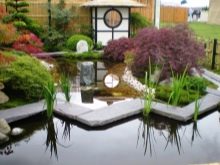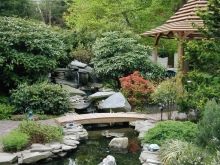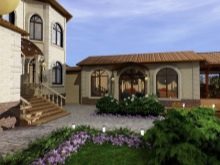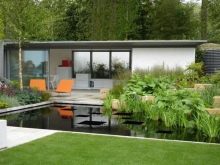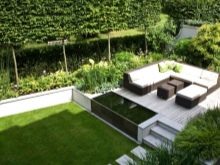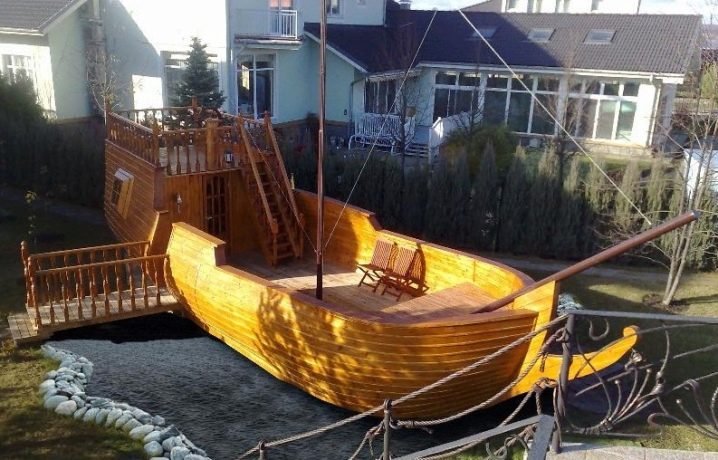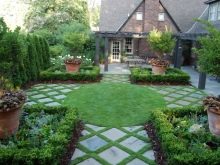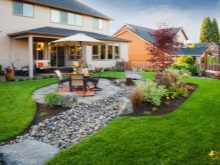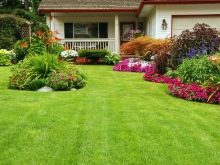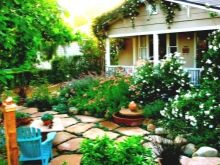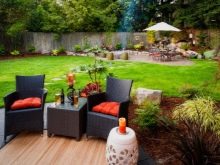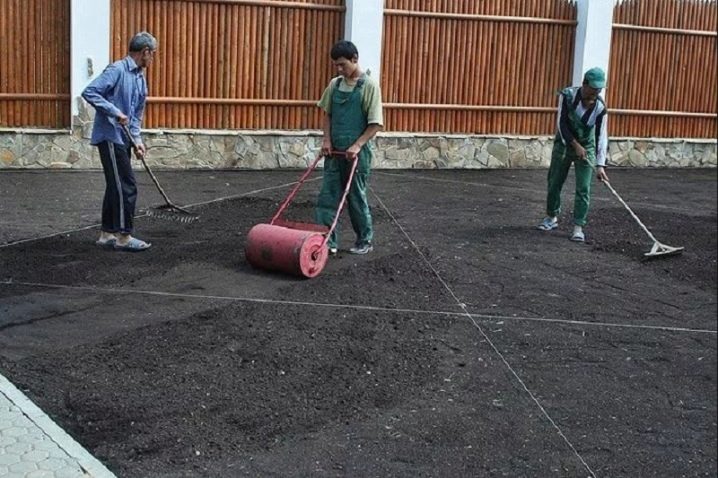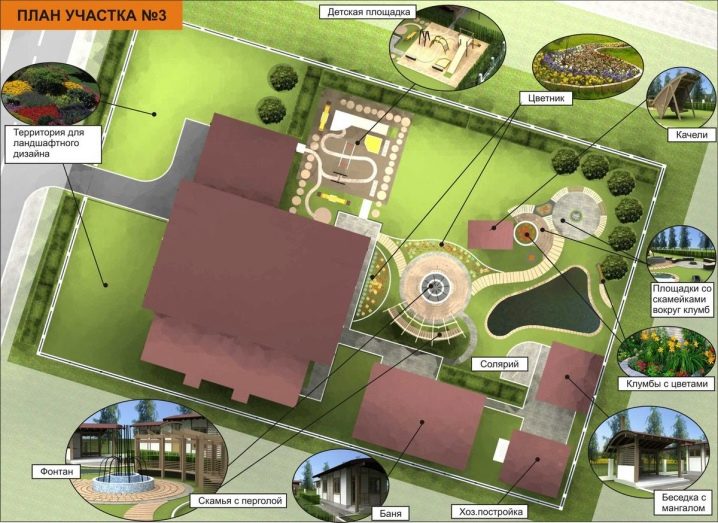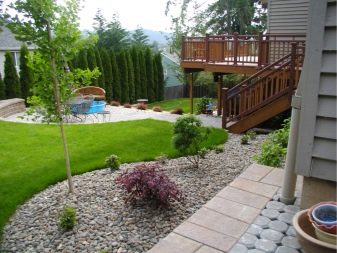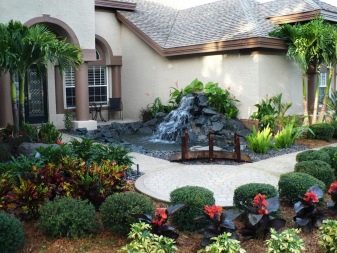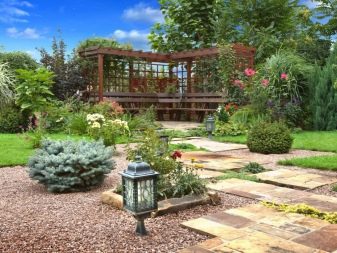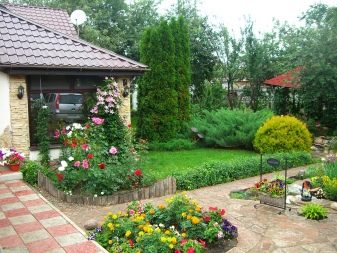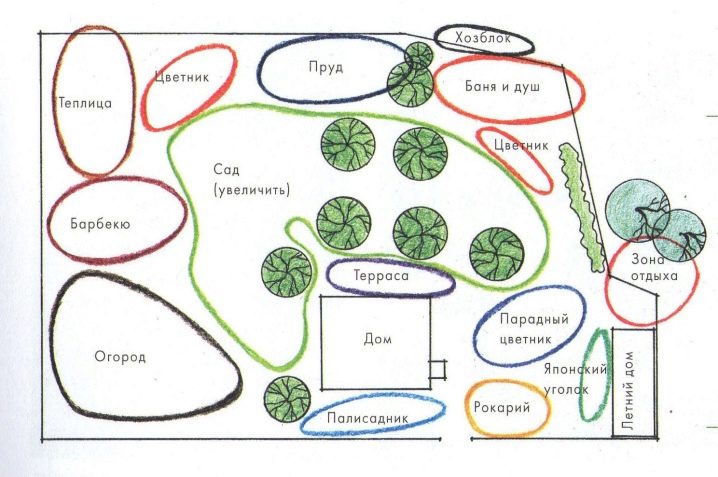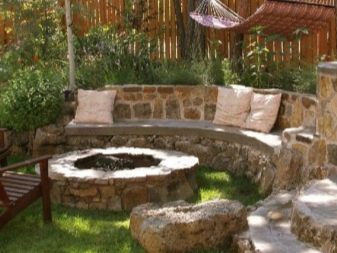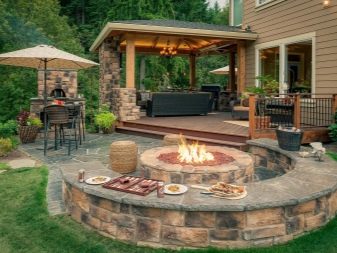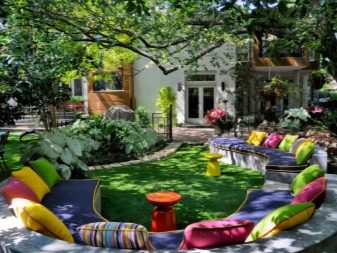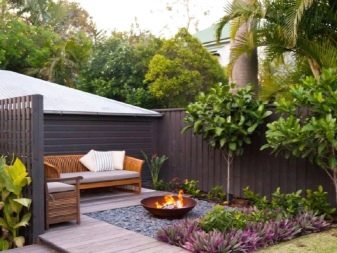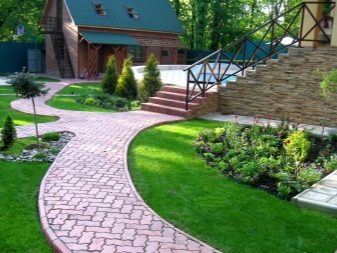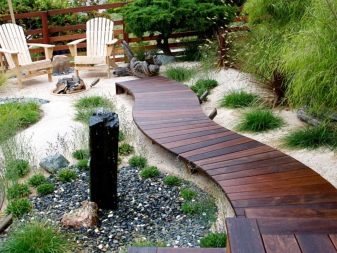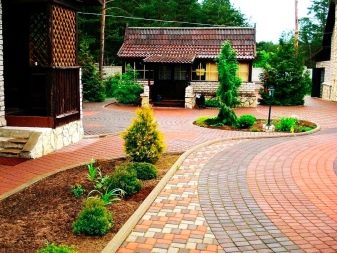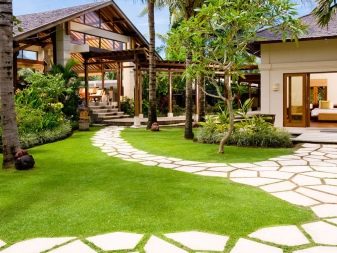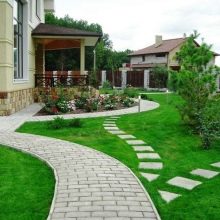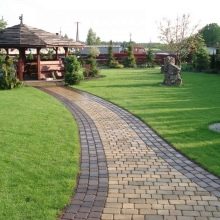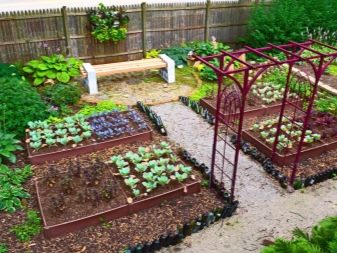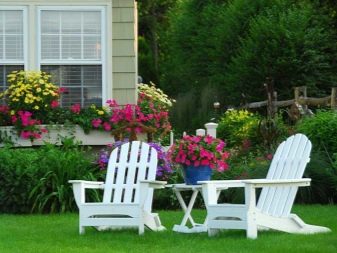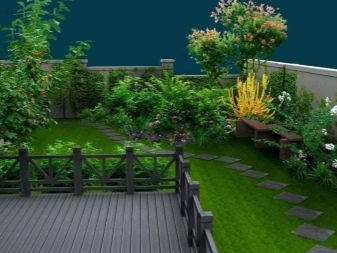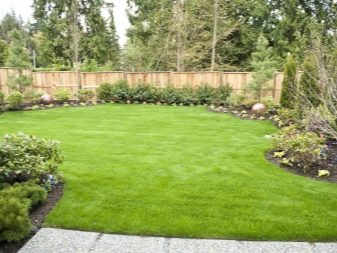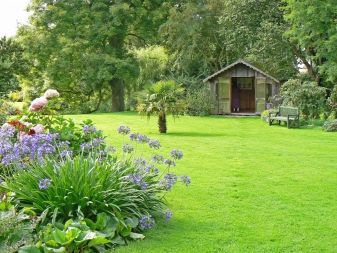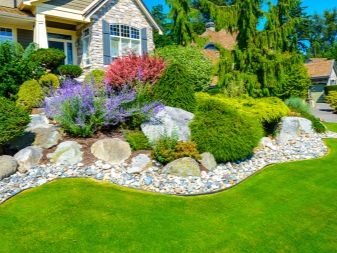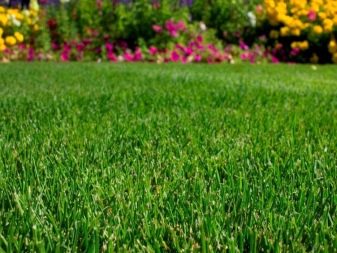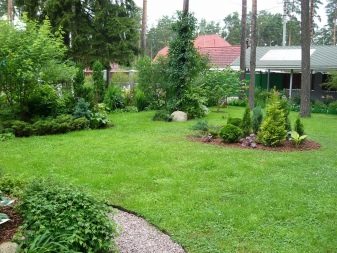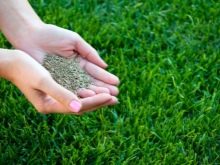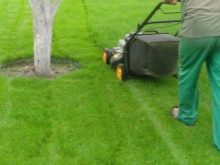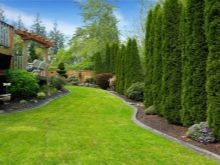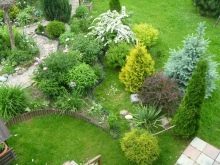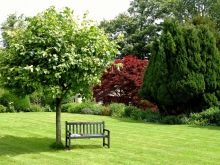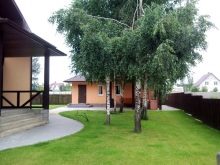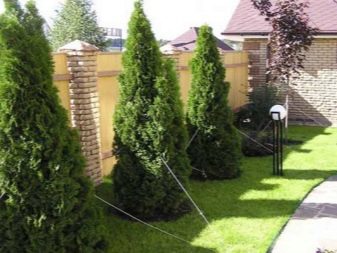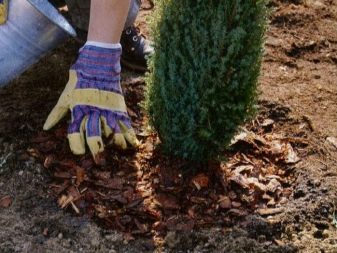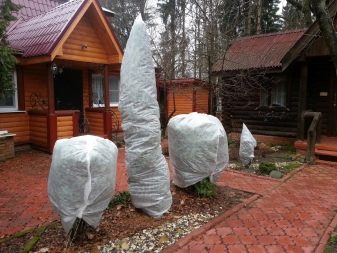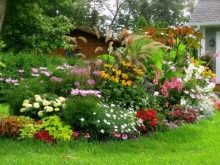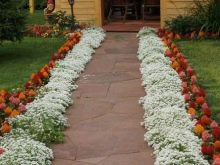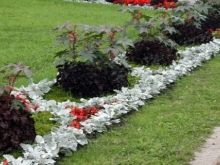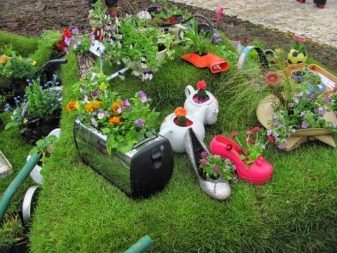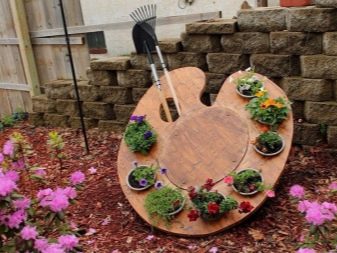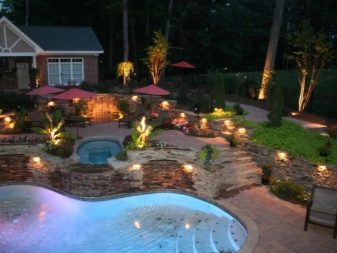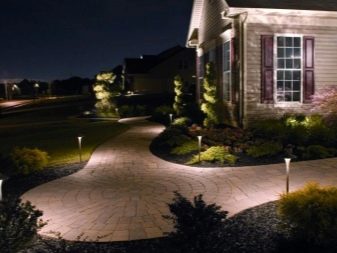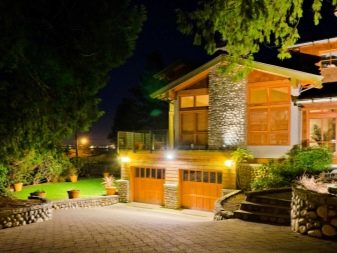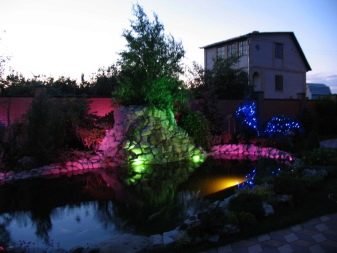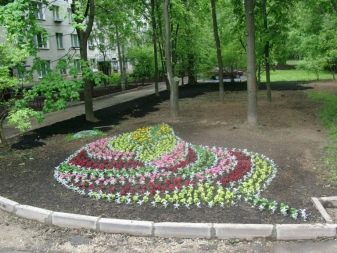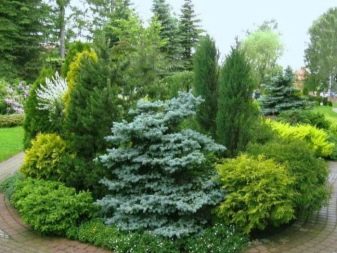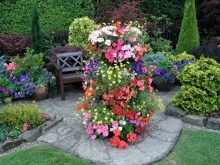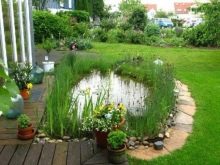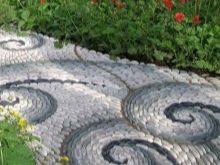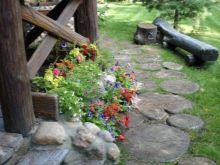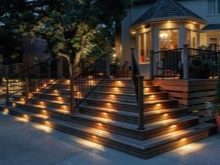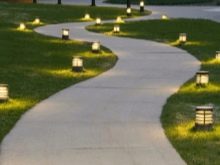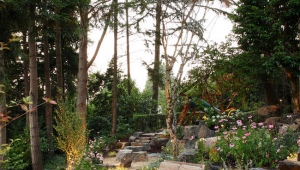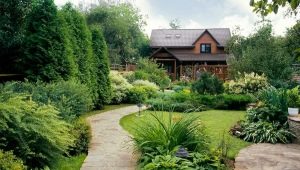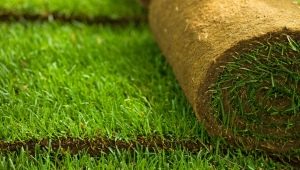Beautiful ideas of landscape design country house
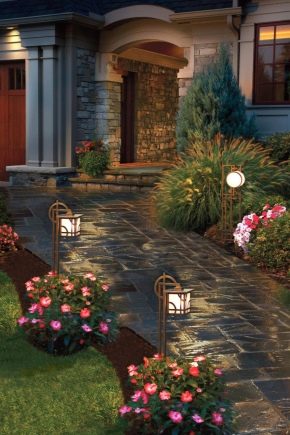
A country holiday plot is always great. Create your own small oasis and a secluded corner where you can hide from the noisy metropolis and enjoy peace in harmony with nature, the power of everyone. Developing landscape design is not an easy task, but fascinating and interesting. At the same time, trees, flowers, green lawn, land relief and lighting play an important role. But it is not enough just to plant any seeds and seedlings.
Landscape design is a whole science, which has its own rules and laws. Everyone who has the desire and a little imagination will be able to learn all the rules, and then create the perfect plot. In addition, it is important to be able to care for plants and have an artistic taste, as well as to remember the basic rule of any design - to harmoniously combine all the elements and adhere to the same style.
Special features
Before starting work on the arrangement of the site, it is important to understand that this is a continuous process that will never end. Plants and flowers require constant care, watering and watering, the lawn must often be trimmed, and the bushes are periodically brought into shape. But if the work is done with high quality and competently, then the site will always look neat and attractive.
Colour
As with the interior design, the design of the site should be carried out in the same style and color scheme:
- Monophonic. The easiest option of registration of a site is a monochromatic color solution. To do this, you can combine all sorts of shades of the same range. With this design, it is easier to make the design of the site complete and not overloaded.
- Two-ton. In this case, you must choose one color that perfectly matches green. The best options: brown, white, purple and purple. And by choosing one of the shades, you can easily decorate the site with suitable flowers, sculptures, benches and other elements. It is not recommended to combine green with blue and red.
- Multicolor. The most popular option and at first glance it seemsthe only attractive and simple. But in this case, you can make a lot of mistakes and overdo it with variegation and brightness. In order not to turn the plot into a color kaleidoscope, it is recommended to use no more than five different shades.
Styles
The choice of style depends on the basic preferences and capabilities.
Classic
Classic is a universal option that can be used on any site. All green plantings, trees and bushes should have an ideal geometric shape: sphere, cylinder, oval. It is important to maintain symmetry. A fountain or a round pond, benches, gazebos of various sizes, arches and outdoor flowerpots fit perfectly in this style. The ideal green supplement is spruce, rose, ivy, lilac, jasmine and honeysuckle. And the basic rule of the classic style is a perfectly trimmed lawn.
Rustic
The absolute opposite of the classics. The chaotic arrangement of elements, different plants, differing in size and color of the buds, as well as the absence of geometric shapes are the distinctive characteristics of this direction. Flowers can be planted randomly and in different places of the site.Excellent for this sunflower, mallow, nasturtium. The flowerbeds and flowerpots themselves can be scattered around the area and have a bright color or an intricate shape.
The site can be supplemented with original elements: clay pots, wooden wheel, decorative mill, wicker fence of willow.
When creating paths, flower beds and decorative elements, preference is given to natural materials: wood, sand or stone.
English
English style can be described as a synonym for restraint. The main task is to preserve the natural nature in a more well-groomed form. Hedges and arches with ivy and grapes fit perfectly into the hilly terrain with rough paths. Reservoirs may be irregular natural shape. Also ideally complement the composition of blooming flower beds and colorful bushes near the house.
Provence
This is an elegant and light style that can be transferred to romantic France. And it is possible to recreate such a direction on any site. The main thing is to abandon clear lines, use delicate flowers to decorate the site. Instead of the usual lawn, you can use grass with small flowers - they will create a more natural sloppy look that will play into your hand in this particular style.
Be sure to plant lavender on the plot - it will fill the garden with a delicate and delicate aroma. For this style it is recommended to use light shades when decorating the walls of the house and arbors. The fence and pergola can be covered with ivy or grapes.
Preference is better to give a natural wood pattern or natural stone.
Japanese
The main difference between the village and other styles is the presence of a stream or reservoir with a bridge. Original and interesting will look the area, decorated with a garden of stones and small bushes. Juniper, dwarf trees, jasmine, rhododendron, fern will help to move to the bliss of harmony and tranquility - they are perfectly combined with water and stones.
Modern
This is an amazing direction with bright colors, unusual shapes and sculptures on the site. In this case, the lines of the facade of the house should be repeated in the area: paths, street flower beds, garden sculptures and furniture. For example, a bench can repeat plant lines or tree branches.
Thematic
This style will allow you to recreate all the fantasies of the owner on one site. For example, a territory can be framed in a maritime style, where flowers will grow in a boat, and a gazebo will look more like a cabin of a ship captain.
Today in the fashion of landscape design conciseness and simplicity. And it is important to harmoniously combine the simple elements with each other.
Layout
Planning of the site begins with a basic idea, which further acquires the following stages. The excessive accumulation of various figures, incompatible colors and sculptures of various forms has long ceased to be popular and attractive. Even a designer and original composition in combination with other catchy and intricate forms can lose its charm.
Therefore, before starting work, it is necessary to visualize ideas, as well as develop a plot plan on paper. And it is important not to be afraid to use bold decisions and trust intuition.
When developing a site plan it is important to consider:
- Terrain and natural terrain. You need to know about the presence of holes, ravines, hills, lowlands and slopes.
- The shape of the plot. The most common are square or rectangular areas, but there may also be triangular and L-shaped gardens. It is necessary to take into account such features and be able to beat the shortcomings.
- The location of buildings and other buildings. It is important that the style of the house with a porch fit into the landscape design.
- Soil typeIt depends on what plants and flowers can be planted on the site.
- The location of the site relative to the cardinal points. It is very important for the cultivation of vegetables, berries and herbs, as well as planting trees, bushes and flowers.
- Ground water level.
- Available growing plants - tall trees, bushes and perennials.
The next stage of design planning and design will be the design of the project:
- Mark on the plan the existing buildings, extensions near the house and facilities. Determine the location for each functional area and the location of the tracks. Rely solely on real needs.
- Develop a plan for electricians taking into account technical and decorative lighting, as well as the layout of irrigation and water supply systems.
- Pick the overall style of the site.
- Decide on the plants, trees and flowers in the area.
- Pick up the necessary types of plants and seedlings.
- Fencing and fencing - necessary attribute of any site. Think of how to beat the fence around the perimeter of the territory. For example, a gray nondescript version can be decorated with a hedge of ivy, grapes or blooming ipomoea. To do this, plant seedlings or seeds in the middle of spring along the fence and take care of additional supports for creeping bushes.
- If the layout and size of the site allow, you can place a pond or other body of water. It is allowed to run into the water carps or other fish that take root in the ponds.
Ideally thought-out layout of the dacha will allow you to plunge into the world of incredible intimacy with nature and give the opportunity to enjoy an oasis of greenery and freshness.
Zoning
First of all, the plot is divided into main zones: residential, garden, vegetable garden, recreation area. Depending on preferences and desires, you can add such details as a garage, summer kitchen, bath, shower and a place for walking animals. In the residential area there is a house, a sauna, a closed courtyard, a terrace and a garage.
If the plot is used exclusively for recreation, and not as a territory for growing crops, it is a good idea to save several beds for fresh vegetables and greens.
In the recreation area you can arrange a gazebo, barbecue, benches, swings or a hammock. It is also permissible to allocate territory for children with soft grass and low trees. For recreation and games with children it is important to choose the right flowers and plants – they must not have thorns and thorns.
The tracks form the internal geometry of the site.Paths should be smooth, beautifully bent and not have clear lines or straight turns. The general scheme depends on which areas of the site need access. From the central path narrow paths can scatter in different directions of the garden.
Paths can be made of stones, round tree cuts, paving slabs or cement. The cement path looks dull and uninteresting, you can give it a special charm with a small fence made of bricks or natural stones.
You can also decorate the path on the sides with a bright floral carpet. The width of the flower stripes can vary from a few centimeters to half a meter. It all depends on the size of the site and the overall composition. The width of the path should be comfortable for the passage of two people, the optimal size is 1-1.5 m, and the surface itself should be smooth, without any inclinations in the middle, otherwise water will accumulate on the path.
If you plan to grow fresh vegetables and greens in the garden, then it is better to single out the southern part of the garden for a vegetable garden, and to plant trees on the northern side or to arrange farm buildings. The central area is to provide a recreation area and decorate it with bushes and flowerpots with flowers.Make sure that the flowerbeds remain blooming throughout the summer season.
The main problem of any area in 6 or 10 acres can be uneven relief. Dealing with this problem can be time consuming and inefficient.
In addition, for some styles it is even preferable, so the designers recommend, if possible, not to level the hills and try to beat the track on the slope.
Gardening
After zoning and creating paths, you can proceed to landscaping the site. This process is the basis of vegetable design. All plantings should be in harmony with each other.
Mandatory part of any site is the lawn. This is not just a decorative element, as the grass absorbs excess moisture and dust, but instead gives freshness and purity. The lawn is selected based on the purpose of the lawn. If you leave the usual weed greens, the territory will look sloppy and disharmonious. At one site in different zones, you can use different types of lawn.
If you need an unpretentious grass that does not require frequent cutting, it is better to choose a mixture of fescue, meadow grass and bent field.It is recommended to choose a more rigid and dense grass - a sports lawn for a walking and animal games area, and a respectable English parterre for decor.
A garden lawn is suitable for landscaping in the shade of the plot. If you are new to landscape design, then in the first year it is better to use the universal option - it is less demanding to care, and also maintains a beautiful and neat appearance for a long time. You can use ready-made lawns - they quickly bring the plot in order.
Recommendations for the cultivation and care of lawn grass:
- The first step is to get rid of weeds. This task is perfectly handled by modern preparations for weeds. The chemical irrigates a part of the territory that needs to be treated, and then (based on instructions) after some time the top layer of the earth together with the weed grass is removed. After exposure to chemicals, it is necessary to give the soil a "rest".
- Before planting grass, you must dig up and level the ground. The soil should be loose (without lumps). Part of the soil must be prepared in advance - it will be needed later for planting.In order for the grass to grow faster, the soil should be fed with mineral fertilizers.
- After ramming, you can start planting a lawn and sow the seeds. Top need to sprinkle dry earth - this will protect the seeds from birds.
- When the grass germinates, you may need to plant additional areas that will remain without greenery.
- Mowing the lawn is only necessary on dry days, and then watering abundantly.
Not the last role is played by coniferous and deciduous trees and bushes. Evergreens such as cypress, thuja, juniper, yew are super popular. They do not grow very high and do not give a large shade, which is especially important for a small plot. With the help of clippers, they can be given almost any shape.
You can plant seedlings separately or in symmetrical groups. A lonely tree attracts more attention, so it should look perfect throughout the year.
Also great for a suburban or suburban area suitable higher trees: walnut, chestnut, maple, oak, spruce, linden, ash. If they are planted in a group, the highest should be in the center, and at the edges should be placed low bushes that will add a composition of brightness and expressiveness.
You can plant young trees around the perimeter of the site, then after a few years you will get a great hedge.
Tips for the care of conifers:
- The best time to plant seedlings is autumn or early spring.
- Before planting it is necessary to feed the soil with peat, turf and sand. And after planting it is plentiful to water the trees and feed it with mineral fertilizers.
- The distance between seedlings should be 1.5-2 m.
- In the first winter and up to five years, the tree must be sheltered to protect against wind and cold in the winter.
Flowers in landscape design create a color palette of the garden, which consists of separate compositions. Flowerbeds and outdoor flowerpots with flowers are not necessarily an old tire with primer. Creating an elegant and thoughtful composition requires imagination and skill. Flowering plants should smoothly replace each other. Designers came up with three original ways of growing flowers:
- Mixborder - is a large flowerbed in which different flowers are grown in groups.
- Border - a classic planting low flowers along the tracks.
- Rabatka - a floral carpet that borders the lawn.
Gardening and landscaping of the dacha plot is an important complex of landscape works for creating decorative compositions, planting trees and shrubs, creating hedges and flower gardens giving birth to harmony and beauty.
Decor
The decoration of the plot with your own hands is a difficult and long business, but very interesting and fascinating. In addition, it is always pleasant to look at the beauty created by yourself. Original and interesting look decorative items made from old things and objects. This may be furniture, an old chest, rubber boots or dishes. Any unnecessary things can be given a second life and used on the site for growing flowers.
Often, site owners ignore the basic rule - they choose different styles and a lot of decorative elements for one site. The result is a chaotic composition, more like a mess and piling up. Each element must harmoniously fit into the overall composition and be combined with other details.
Beautifully decorated front door in the house will give confidence and solidity to the suburban area. Even if the house is located along the road, you can arrange the entrance through a closed veranda or patio.
Street lighting will give a fabulous and magical atmosphere, and also make the site more interesting in the evenings than during the day. It is better to use cold light for tracks, turns and entrances in the territory, and warm light in the rest area. Illumination of a reservoir or pool will create beautiful iridescent highlights. You can also additionally illuminate trees, bushes and flower beds.
Beautiful examples
In creating a beautiful landscape, you must first adhere to a single style. And before proceeding to the improvement of the site, We recommend to look at the finished landscape design projects:
- A great and easy way to add variety to the villa-garden plot is to use ridges. These are flower zones near the tracks. They can be located on one or two sides. Bilateral more often projected in the central part of the site, and unilateral can resemble a flower island. The main rule - plants should have a low stem, have bright buds and be combined with each other in color.
- Evergreen conifers fit perfectly into any landscape design and look great at any time of the year.
- Vertical flower beds will help to give a small plot charm and charm.
- If there is a ravine or a pit in the plot in which water accumulates, turn this disadvantage into an advantage. Create a small pond with bubbling water. Around the pond, you can make a stony path and plant perennial flowers: lilies and forget-me-nots.
- Paths with patterns of pebbles look incredibly original and will make all the guests admire.
- In the rustic style, instead of the usual street bench, you can use a whole tree.
- Lighting the site performs two main functions: it allows you to decorate the area at night and to secure movement at night. Therefore, it is very important to consider lighting the entrance areas, steps, railings and paths.
- On different sides of the track, you can use the built-in lights, which are protected from corrosion and are not afraid of temperature changes and moisture.
For information on how to design the landscape of a country house, see the video below.
